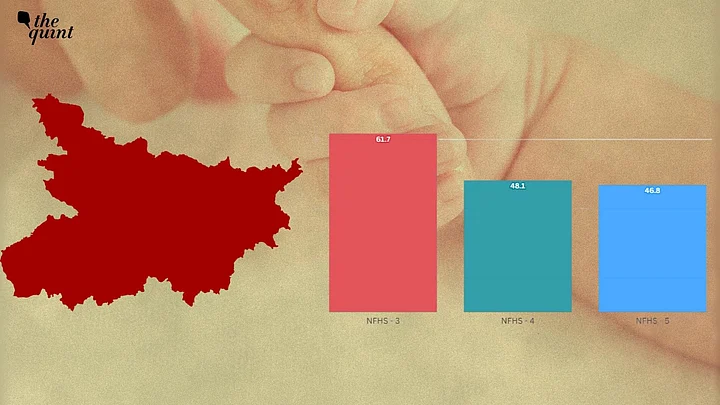The state of Bihar has the second highest infant mortality rate (IMR) of 46.8 deaths per every 1,000 live births as per the official data available in the National Family Health Survey (NFHS)-5. For context, the figure for the entire India stood at 35.2. For the unversed, the IMR is the probability of dying within birth and the child’s first birthday.
With the stage set for the upcoming Bihar assembly elections, the spotlight remains on the prominent leaders and the rallies conducted by different political parties to gain support of the voters.
The National Democratic Alliance (NDA) will be looking to retain the state that it has had a stronghold on, thanks to Bihar Chief Minister Nitish Kumar, and the opposition, with Tejashwi Yadav at its face, will be looking to change the status quo.
Since June of this year, The Quint has been publishing different data stories as part of its effort to bring simplified facts to its readers. This section will examine how the infant mortality rate and total fertility rate (TFR) have evolved over the years, utilising data from the NFHS-3 (2005-06), NFHS-4 (2015-16), and NFHS-5 (2019-21).
Has the Infant Mortality Rate Come Down in Bihar?
As per the NFHS-3, the IMR for Bihar stood at 61.7 deaths per 1,000 live births, whereas the figure for the country was 57. This number for the state decreased to 48.1 in NFHS-4, marking a significant improvement within a decade (approximately).
However, the IMR in NFHS-5 for Bihar was 46.8. This showed that between the last two surveys, the state did not see a major shift.
As per a press release shared by the Ministry of Health and Family Welfare, the IMR for Bihar has consistently dropped from 2015 and stood at 29 in 2019.
This number was taken from the Sample Registration System (SRS) Bulletin of the Registrar General of India.
The IMR for Bihar was lower than the national average (30) in 2019.
What Do the Surveys Tell Us About the Total Fertility Rate in Bihar?
The data available on the official NFHS-3 showed that the state had a TFR of 4, much higher than the figure for India which stood at 2.68.
The NFHS defines the total fertility rate as the average number of children a woman would have by the end of her childbearing years at the current age-specific fertility rates. The sample size for the survey was the 15-49 age group.
The number has seen a drop in the following two surveys. NFHS-4 put the TFR for Bihar at 3.41, while the number in NFHS-5 stood at 2.98.
A report by the Economic Times published in 2024 said that thirty-one out of states and Union Territories in the country have successfully achieved the replacement level of 2.1 fertility rate.
However, the report further said that the states of Bihar, Uttar Pradesh, Meghalaya, Manipur, and Jharkhand had higher than desired fertility rates.
(Data sourced: National Family Health Survey (NFHS): State- and Region-wise Statistical Indicators Data on Family Profile and Health Status in India [Data set]. Dataful.) The data for NFHS-4 and NFHS-5 was sourced from Dataful.
